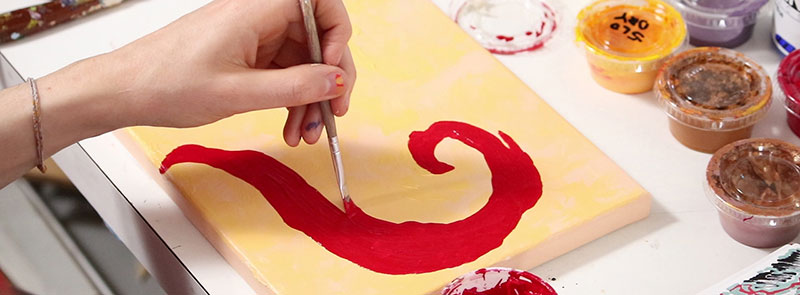Prompt
Create a portrait that expresses an emotional mood by using an unrealistic color scheme.
For some people it can be helpful to have a specific word to refer to the mood: sullen, perky, whimsical, livid, energetic, etc.
Look up the word in the dictionary to get ideas for how you might represent your portrait.

Thumbnail Sketches
There are many ways you can approach using a color scheme that isn’t represented in real life. Be open and willing to play around with various options at the thumbnail sketch stage.
We recommend doing at least a few thumbnail sketches in color so you can preview what the color scheme will be like.
Erica, Crispy, M. Tordy, Creature design thumbnails, Johanna, Radish monotype thumbnails, Neil Espinosa, Sarah C. McGill, Crispy, Jordan McCracken-Foster, Gouache tutorial thumbnailsl, Ginger, Ashley Tanelle, Wadalafer, Purple/Yellow still life thumbnails, Soft pastel cookies thumbnails, Triplegem
Approaches to Color
You can choose to work spontaneously, so that your color decisions are made in the moment, as a reaction to your process.
If you enjoy working from observation, you can simulate an unusual color scheme by getting a colored light bulb to for example, cast a red light on your face.
Lucas Samaras is a photographer who is known for using colored lights in his portraits.

Examples
Jen K., Ashley Tanelle, Johanna, Lisa Hufstetler, Julie R., Tal E.
Hear from an Art Prof Student

I always said to myself, ‘I like drawing people but I’m terrible at drawing people.’
I feel like just getting a bunch of those drawings out of the way, I feel much more comfortable going into a portrait and knowing where to start.
I learned colors can change just from different planes of the face and that you’ve go to incorporate both cool and warm colors.“
Jen Noelle
Inspiration
Emile Nolde, Jenny Saville, Marc Chagall, Lucas Samaras
Tips
- Many colors are associated with specific emotions. For example, red is often associated with anger, and blue is often perceived as being melancholy.
- Consider that colors often have different meanings depending on the culture and time period. For example, in Chinese culture, red often symbolizes good fortune and luck.
Reference Photo Tips
- Try changing the colors, brightness, and contrast in your reference photo, it’s a fun way to mess around with color quickly.
- Often working from a raw reference photo can make your life tougher than it needs to be when you are changing the colors dramatically.
- Watch our live stream demo of this process
Reference Photos
art media
Use any color media you want!
Paint Media
Visit these pages for supply lists: watercolor, gouache, acryl gouache, oils, water mixable oils, acrylics.

Drawing Media
ballpoint pen/gel pens, dip pen, brush pen markers, Caran d’Ache crayons, graphite powder, colored pencil, soft pastel, oil pastel, pencil, charcoal, ink wash, scratchboard, wet charcoal, oil sticks
DIGITAL SOFTWARE OPTIONS
Procreate, Krita, Adobe Photoshop, Clip Studio Paint, Paint Tool SAI, Adobe Fresco, MediBang Paint, Gimp

We want to share your progress!

- Did you do this lesson?
- Submit to have your work to be posted here on this page or mentioned in a live stream.
How To Create Color Palettes
Planning a color scheme for an artwork is an effective way to achieve visual cohesion and intent in your artwork. Color schemes are an effective way of establishing a mood in a painting, as well as creating visual contrast and textures.
There are many ways to collect ideas for color schemes and apply them to your creative process. Art Prof Clara Lieu and Teaching Artist Lauryn Welch lead this discussion.
Portrait Background Ideas
See a step by step drawing demo on how you can create unusual color mixtures to make a portrait drawing with markers and Photoshop.
Explained are ways to tweak reference photos to get ideas for colors, and how to translate that into a drawing with a dynamic range of colors.
Demo by Art Prof Clara Lieu and Teaching Artist Jordan McCracken-Foster.
Portrait Background Ideas
This video provides ideas for how to create backgrounds for portraits so that your compositions are visually dynamic and engaging.
Backgrounds are often neglected, especially in portraits where the focus is usually on the face. However, backgrounds can have a great impact on the way a portrait comes across, especially in terms of conveying a specific narrative.
Discussion led by Art Prof Clara Lieu and Teaching Artists Cat Huang and Alex Rowe.
- Video walkthrough & more
- Watch the 3 min. version
- Watch the 40 min. version
- Slideshow
As a free educational source, Art Prof uses Amazon affiliate links (found in this page) to help pay the bills. This means, Art Prof earns from qualifying purchases.





















































